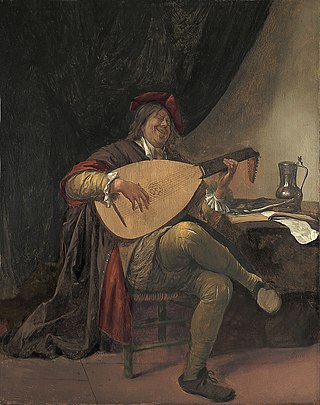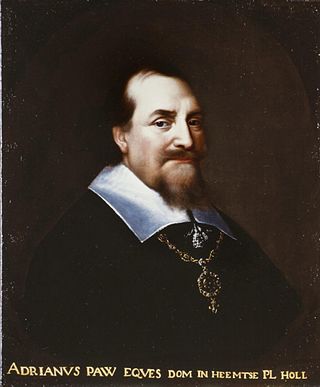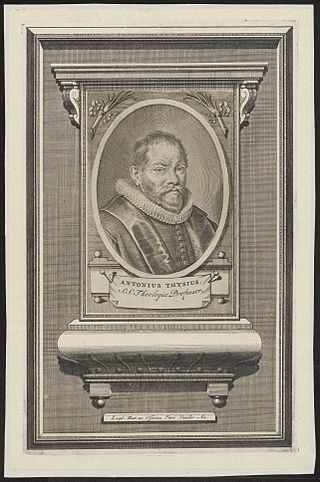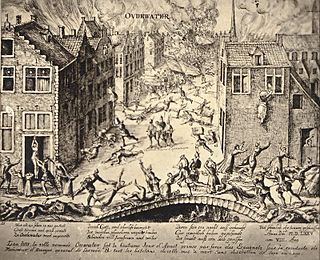
Jan Havickszoon Steen was a Dutch Golden Age painter, one of the leading genre painters of the 17th century. His works are known for their psychological insight, sense of humour and abundance of colour.

"Greensleeves" is a traditional English folk song. A broadside ballad by the name "A Newe Northen Dittye of ye Ladye Greene Sleves" was registered by Richard Jones at the London Stationers' Company in September 1580, and the tune is found in several late 16th-century and early 17th-century sources, such as Ballet's MS Lute Book and Het Luitboek van Thysius, as well as various manuscripts preserved in the Seeley Historical Library in the University of Cambridge.

Adriaen Pietersz van de Venne, was a versatile Dutch Golden Age painter of allegories, genre subjects, and portraits, as well as a miniaturist, book illustrator, designer of political satires, and versifier.

Bergamask, bergomask, bergamesca, or bergamasca, is a dance and associated melody and chord progression.

The Fortune Teller is a painting by Italian Baroque artist Michelangelo Merisi da Caravaggio. It exists in two versions, both by Caravaggio, the first from c. 1594, the second from c. 1595. The dates in both cases are disputed.

Adriaen Cornelissen van der Donck was a lawyer and landowner in New Netherland after whose honorific Jonkheer the city of Yonkers, New York, is named. Although he was not, as sometimes claimed, the first lawyer in the Dutch colony, Van der Donck was a leader in the political life of New Amsterdam, and an activist for Dutch-style republican government in the Dutch West India Company-run trading post.

Adriaan Pauw, knight, heer van Heemstede, Bennebroek, Nieuwerkerk etc. was Grand Pensionary of Holland from 1631 to 1636 and from 1651 to 1653.

Joachim van den Hove was a Flemish/Dutch composer and a lutenist. He composed works for lute solo and for lute and voice. Moreover, he wrote many arrangements for lute of Italian, French, and English vocal and instrumental music, and of Flemish/Dutch folk music. Van den Hove disputes with Adriaensen and Vallet the distinction of being the most important representative of 17th century Dutch lute music.

Joos van Craesbeeck (c. 1605/06 – c. 1660) was a Flemish baker and a painter who played an important role in the development of Flemish genre painting in the mid-17th century through his tavern scenes and dissolute portraits. His genre scenes depict low-life figures as well as scenes of middle-class people. He created a few religiously themed compositions.

The Bibliotheca Thysiana was erected in 1655 to house the book collection of the lawyer Johannes Thysius (1621–1653). Upon his early death, he left a legacy of 20,000 guilders for the building of a public library with a custodian's dwelling. Designed by the architect Arent van ‘s-Gravensande, the building follows the Dutch Classical style and is regarded as one of the jewels of Dutch 17th-century architecture. Bibliotheca Thysiana is one of the Top 100 Dutch heritage sites. It is distinguished by its balanced proportions and the purity of its Ionic order on top of a high basement.

Pieter Jansz. Quast was a Dutch Golden Age painter, draughtsman of portraits and sculptor.

Pieter Bout was a Flemish painter, draughtsman and etcher. He is known mainly for his landscapes, city, coast and country views and architectural scenes painted in a style reminiscent of earlier Flemish masters such as Jan Brueghel the Elder.

Antonius Thysius was a Dutch Reformed theologian, professor at the University of Harderwijk and University of Leiden.

Antonius Walaeus was a Dutch Calvinist minister, theologian, and academic.

Adriaen Verwer was a Dutch Mennonite merchant, scholar, philosopher and linguist. He wrote books on language, religion and maritime law. He is best known for his grammar Linguae Belgicae, published anonymously in 1707. He is often regarded as the linguistic mentor of his younger friend Lambert ten Kate.

Adriaan Kluit was a Dutch scholar, important in Dutch linguistics. He was born in Dordrecht. He was rector of the Latin school in Alkmaar and Middelburg. In 1779 he became the professor of history at the University of Leiden, remaining there until his death.

Pieter Biesboer, is a Dutch art historian and prolific writer on 17th-century Dutch art. His specialty is art from Haarlem.

Lucas Smout the Younger or Lucas Smaut was a Flemish painter of coastal and country scenes who was active in Antwerp.

The siege of Oudewater was an event during the Eighty Years' War that took place in the Dutch town of Oudewater, culminating in the Oudewater Massacre. The siege by Spanish troops started on 19 July 1575 and ended on 7 August 1575, when the town was taken by storm and plundered.

The Master of the Brandon Portrait or Portraits was an Early Netherlandish painter active about 1510–1530 in Bruges and at the court of Henry VIII in England. His notname is based on the Portrait of Charles Brandon, Earl of Suffolk now in a private collection. He may be the same person as Joannes Corvus.




















